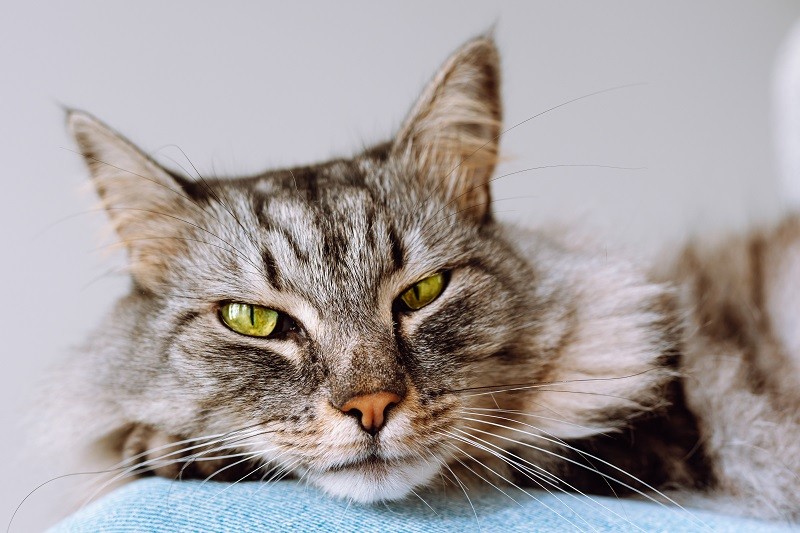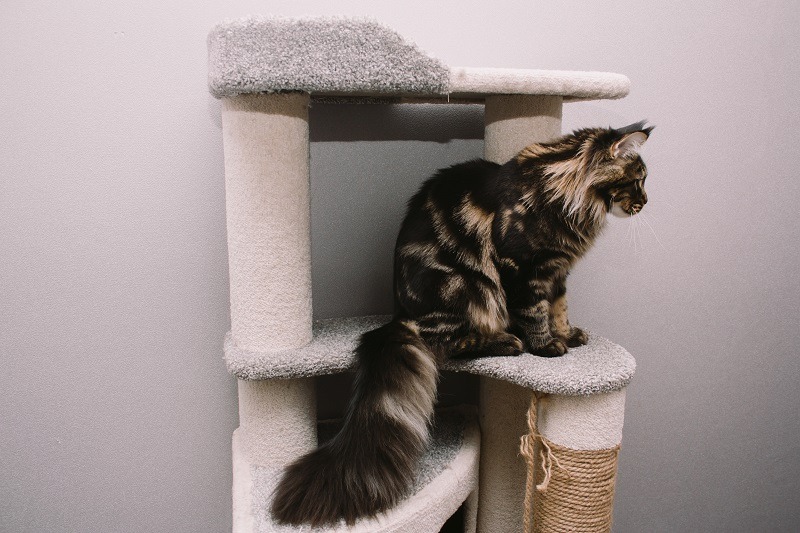It wasn’t that long ago that our feline friends were happily ruling the tops of our cupboards or clinging to our curtains. Then came the cat tree – a piece of furniture that didn’t just provide a spot for your cat to perch but revolutionized how indoor cats live.
These structures started gaining traction back in the 1970s, a time when pet owners began to realize that their purring companions needed more than food and the occasional cuddle. The initial spark of popularity grew out of loving necessity as homeowners saw the benefits of giving cats their own vertical realm.
Over the years, cat trees have transformed from simple carpeted posts into savvy, complex pieces of furniture. Their evolution echoes our growing understanding of feline needs and the rise in pet ownership among urban dwellers.
More and more, people are waking up to the idea that a happy cat means a happy home, and a significant part of that happiness comes from having the space to climb and explore. Coupled with many of us becoming more eco-aware, the transition to eco-friendly cat trees makes total sense.
The leap toward eco-friendly options is all about responding to increased awareness about sustainability. We’re not just talking about saving the planet—though that’s a massive part of it—but also ensuring our furry companions live in spaces that are safe and healthy.
People are ditching the mass-market models in favor of alternatives that use natural materials like bamboo and recycled wood. It’s about making choices that mirror our values while also delivering on comfort and style, both for us and our cats.
So, a rise in demand for eco-friendly cat furniture means aligning pet care with environmental care, a win-win for any true-blue pet lover.
Eco-Friendly Materials: A Sustainable Choice

Choosing the right materials for your cat’s hangout spot is about more than style—it’s about safety and sustainability. Traditional cat trees might still use plastic or chemically treated wood, but eco-friendly options shine with their planet-conscious approach. Picture this: beautiful bamboo stems, sturdy and renewable, that can withstand your cat’s most energetic play sessions.
So, what exactly makes a cat tree eco-friendly? For starters, these models steer clear of toxins like formaldehyde, a chemical that’s been a concern among more conventional options. You won’t find it in the truly eco-conscious brands. Instead, they opt for safer alternatives—the ones that respect both your cat’s well-being and Mother Earth’s resources.
Let’s break it down with some materials frequently found in eco-friendly cat trees. Bamboo, as I mentioned, is a winner. It’s rapidly renewable, fabulous for any interior design, and, most importantly, super safe for pets. Recycled wood and natural sisal (a biodegradable and strong fiber perfect for scratching) count as other favorites. These jewels offer the best of both worlds: function and safety.
Navigating potential hazards like formaldehyde isn’t just about what’s in the tree, but about peace of mind. Pet parents are becoming more savvy and discerning, raising the bar for what they want in their home. Picking products with non-toxic finishes and sustainably sourced parts isn’t just a style move, it’s a statement of care.
Choosing wisely means prioritizing products that favor our eco-conscious instincts. Because at the end of the day, you want your space to reflect your values. An eco-friendly cat tree is a testament to meeting that commitment, offering a safe playground for your cat and a responsible choice for the environment.
Why Cats and Owners Love Cat Trees
Cat trees aren’t just about style points in your living room; they’re about understanding what makes your feline tick. Cats have this natural instinct to climb and survey their territory—whether it’s an expansive yard or your cozy apartment. These structures give them that high ground without any of the outdoor risks.
A cat tree isn’t some luxury that only the most pampered cats need. It’s about catering to their instincts and providing a space that meets their needs. Think of it as giving a fish water to swim in. The activity keeps them mentally and physically stimulated, a crucial factor especially for indoor cats who might otherwise miss out on climbing opportunities.
The benefits extend beyond just making your cat happy. By providing a dedicated space for their climbing and scratching, you might just save your furniture from getting clawed up. Giving your cat a designated area can redirect those less-than-desirable behaviors. It’s a win-win situation for maintaining harmony in your home.
I’ve seen and heard so many pet owners light up about the transformative power of a good cat tree. From first-time users to lifelong advocates, having this piece of furniture often makes life easier and more enjoyable for everyone involved.
Cats are more settled, and owners can relax knowing their pets have a place all their own. Eco-friendly options make this even more impactful, knowing they’re safe and sustainable.
When selecting a cat tree, consider designs that offer multiple levels, cozy hideaways, and scratching surfaces. These features cater not just to your cat’s play but also their rest—key components to a happy feline life. Remember, a happy cat means a relaxed and serene home environment. And who doesn’t want that?
The Environmental Impact of Traditional Cat Trees

Traditional cat trees, while popular, often come with hidden environmental costs that might not be immediately obvious. The materials used in many conventional versions include plastics, synthetic fibers, and chemically treated woods that can have a hefty carbon footprint. Enough to give even the most thrifty shopper pause.
The process of manufacturing these trees—which might look harmless on the shelf—involves emissions and waste. It’s a chain that stretches from resource extraction right through to delivery, contributing significantly to pollution and resource depletion.
One big issue is the presence of formaldehyde, a chemical sometimes used in adhesives and finishes. This isn’t just an environmental hazard but a potential health risk, which begs the question: do we really want our beloved pets around that stuff?
Then there’s the question of waste. Traditional cat trees aren’t the easiest to recycle once they’ve seen better days, leading to more landfill contribution. That old, tired piece eventually needs replacing, possibly with another of the same, unless buyers shift to more sustainable options.
Moving to eco-friendly cat trees is a step towards reducing these impacts. With natural materials that break down easier and processes that require less energy, eco-friendly trees are a conscious choice. They hit the sweet spot between being responsible stewards of our planet and attentive caretakers of our pets.
The Dark Side: Cons of Cat Trees
Owning a cat tree might seem like a no-brainer, but it’s not without its downsides. One of the main challenges is space. These structures can be pretty bulky and might not fit so neatly into smaller living environments. It’s a bit of a juggling act finding that perfect spot where it’s accessible for your cat but doesn’t cramp your style. This is one reason we champion for wall-mounted cat trees because it gives your cat the variables it needs while taking up minimal space.
Click Here To See Out Top Recommendation for Wall-Mounted Cat Tree
Another factor to consider is durability. While many trees are built to last, others might not hold up to vigorous kitty antics. Frequent climbing, scratching, and jumping can quickly wear down a poorly made tree. That’s why investing in quality is key. Trust me, you’ll know the difference when something feels robust versus a bit rickety.
Not all cat trees are created equal, particularly when it comes to eco-friendly claims. Some products might not fully disclose the materials used, leaving room for doubt about their environmental credentials. It’s similar to when you’re reading a food label and half the ingredients sound like a chemistry quiz—exactly why it’s vital to research and choose a reputable brand.
There’s also the cost factor. The upfront price of purchasing a high-quality, eco-friendly cat tree can be a bit steep. However, when you weigh this against the potential risk of replacing cheaper versions more often, it might just balance out.
Even with these cons, for many, the benefits far outweigh the drawbacks. But it’s all about knowing what you’re buying into. Consider these points as part of your decision-making, ensuring any cons are addressed before you welcome that new feline jungle gym into your home.
Choosing the Right Eco-Friendly Cat Tree for Your Home
Picking out the right eco-friendly cat tree comes down to a balance of function, form, and responsibility. Consider your cat’s preferences first. If they’re a climber, opt for a taller design with multiple levels. If they’re more into lounging, look for models with cozy, plush areas for them to chill out in.
Aligning the cat tree with your home’s style is another aspect to keep in mind. Luckily, eco-friendly versions often come in sleek and modern designs that fit well into various decor styles—no need for that clunky furniture of days past.
Maintenance is key to extending the life of any cat tree. Regular checks for wear and tear, along with occasional cleaning, can keep it in top shape, making sure it remains a sturdy playground for your feline friend. Also, rotating the position of the tree or rearranging its elements can refresh your cat’s interest.
When it comes to brands, doing a bit of sleuthing pays off. Look for companies with clear sustainability policies, using materials you recognize as eco-friendly like reclaimed wood or organic fabrics. User reviews can give great insights into durability and performance, so don’t skip checking those out.
In the end, choosing an eco-friendly cat tree is an investment not just in your pet’s happiness, but in the planet’s future. It’s about smart choices that provide peace of mind, accentuating your home with an eye toward sustainability that serves both you and your feline friend.

6 Replies to “Why Eco Friendly Cat Trees Are The New Norm”
Love this! We are looking at adopting a cat and this definitely gave me something to consider. It’s crazy how much waste regular cat furniture can create—who knew cat trees could actually be sustainable?
Do eco-friendly ones hold up as well as the traditional ones? And are they easy to clean? Would love to hear what materials are best in terms of durability and scratching.
So glad this helped you as you prepare to adopt—how exciting! And yes, it’s eye-opening how much waste can come from traditional cat furniture. Thankfully, eco-friendly options have come a long way and can absolutely hold up just as well (sometimes even better) than mass-produced alternatives.
In terms of durability and scratching, solid wood bases paired with natural sisal rope are some of the best. They’re tough, cat-approved, and usually easier to clean than carpeted versions. Materials like bamboo and reclaimed wood are also great for strength and sustainability.
We’ll be covering specific materials and cleaning tips in more detail in an upcoming article, so keep an eye out!
Thanks for this awesome guide! As the proud (and admittedly lazy) owner of a couple of chill cats, I love that you highlight picking a tree that suits their personality—mine are definitely more about lounging than climbing. It’s great to know there are sleek, eco-friendly options that won’t mess with my home’s vibe or my laid-back style.
I’m curious, do you have any favorite brands or materials that really stand up to lazy but picky cats? Also, rotating the tree to keep their interest sounds like a smart tip—I’ll have to try that!
Appreciate the reminder that choosing sustainably isn’t just good for my fur babies, but for the planet too. Definitely feeling better about making a smart, stylish choice now!
Thank you for your kind words! Lazy loungers definitely deserve cat trees that fit their vibe, and you’re right, choosing the right materials makes all the difference. Sturdy wood bases paired with household-grade carpet or sisal are usually a hit with laid-back but picky cats because they offer comfort and durability. Eco-friendly trees made from bamboo or reclaimed wood also hold up beautifully and keep things stylish at home.
Rotating the tree is a great idea, sometimes just changing its location near a sunny window can reignite their curiosity. We’ll be sharing more favorite brands and material tips in a future article, so keep an eye out for that!
This is such a thoughtful and well-researched look into something many pet parents often overlook—how our choices for our cats can also impact the planet! I love how this article highlights that cat trees aren’t just fun furniture—they’re essential to our cats’ mental and physical well-being, especially for indoor kitties craving vertical space and stimulation.
The rise of eco-friendly cat trees feels like a natural evolution. Using materials like bamboo, reclaimed wood, and sisal not only makes them safer for our pets but also reflects a deeper sense of responsibility we’re starting to embrace as consumers. It’s a win-win for sustainability and style. Do you prioritize eco-conscious brands when shopping for your pets? When introducing a cat tree to your home, how did your cat react at first?
Thank you so much for your thoughtful comment! It’s wonderful to hear how much you value both your cat’s well-being and the planet. Eco-friendly cat trees really are a win-win—safe, enriching for our cats, and kinder to the environment.
When introducing a cat tree, many cats need a little time to warm up to it. Some will hop right on and claim the highest perch, while others need gentle encouragement with treats, toys, or a sprinkle of catnip to explore.
We’ll be sharing more tips on introducing eco-friendly cat furniture and highlighting our favorite sustainable brands in an upcoming article, so stay tuned!